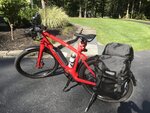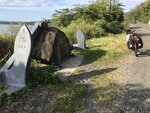Hi there, I'm not sure if you realized or not but you added most of your comments (in bold) to my quote. This meant that most of it was not displayed, due to how EBR treats quotes. So I have copied and pasted each of your comments and will reply to each of them individually, so that they're all displayed by default.
Disagree totally. Large batteries take you further and can be charged more quickly without stressing the battery. 60% of my 30Ah. pack is 18Ah of usable power that has taken me over 80 miles with a light load (50 lbs. of gear) with no undo stress.
How is that a disagreement? My statement was about how far to drain each pack before switching to the next, not how big a pack you should take.
To your point, I do typically take the biggest packs with me I can get. So we actually don't disagree at all.
Easier said than done unless riding from motel to motel or campground to campground.
My long trips this year were all work trips, not touring trips. With work trips, I have found it easy to confirm in advance what storage and charging opportunities there would be.
Invest is the correct word... get a Grin Satiator for proper maintenance.
Would love to. I've looked at the item on the Grin website many times. With the possible and unconfirmed (at least for me) exception of Brose, the Satiator doesn't support any of the charging plugs I need (Bosch, Brose, and Shimano at present). If that ever changes, I strongly expect I'll invest in one. Trust me, I want to have one!

Is there any suggestion of them bringing out new plugs for it for the new e-bike systems on the market?
Yes, use any and all 120V charging opportunities available, not a lot of ferries in Montana I'm assuming.
I live on an island so most trips for me involve one or more ferry trips. I can't speak for anyone else's experience.
I doubt the U.S. Mail Service or Brown will be thrilled with shipping a fully charged lithium pack. Just be self-contained.
I never said courier it, I said send it. I meant pass it on via a friend of a friend. I live on Vancouver Island, which is a very long island, and I have many relatives and friends who live up-island who can pass a battery on to someone else for me. I live near the southern tip of the island, and people come down here from time to time for different reasons.
Yes, use any and all 120V charging opportunities available. However, with a pair of 30Ah packs you won't find yourself stopping and begging for an hour worth of charge time nearly as often.
Probably, but I don't think 30 Ah packs are available for any of my e-bikes. But I do typically take the largest packs I can get, so I'm philosophically right in line with you here.

Is average speed important for some reason?
Yes. Very much so, for me. Like I said before, these were work trips not touring (the subject line is "e-bike travel", not "e-bike touring"). So I had to be at a certain place by a certain time, so I had to know how far it was, estimate how fast I would go, and from there I could estimate how long it would take me.
But even when I am touring, I enjoy performance touring where we challenge ourselves to see how far we can get in a day. It's not for everyone, but it's enjoyable for me. I'm a "set personal bests whenever possible" kind of person on the bike, I have been for a long time.
You are making it more difficult than it really needs to be.
Yes, and I acknowledged as much in what you were replying to. Here is what I said again: "Some people might find the degree of battery management I engaged in would be crazy-making, but I am a strategist at heart and I enjoyed the charge level management challenge!"
So yes, I'm making it more difficult than it needs to be, and I enjoyed that part of it. That's like someone saying cycling is making it more difficult than it needs to be when driving would be easier. Yes, and that's the point!

On a Class-3 ebike you are restricted from all Class-1 biking infrastructure, all National Parks, curbs and all sidewalks. With those restrictions why not just buy an electric-motorcycle, they are a lot easier to mount the license plate. Why is top speed or average speed important when you know it will be faster than when you were riding a standard bike?
Sidewalks? By default all bicycles are restricted/discouraged from sidewalks where I live (British Columbia). So that's not a relevant point to me.
Class-1-specific biking infrastructure? Sure, but my big trips this year were on a mix of highways and city streets (with highways being the bigger chunk of it).
I'm not sure of any e-bike rules for Canada's National Parks, or why I would want to ride in a National Park (except on a highway that goes through one maybe). My touring on both e-bikes and muscle-bikes has always been focused on gaining as much distance as reasonably possible each day.
Why would I want an electric motorcycle? I want power assist, I want to get exercise as I ride (even if I'm riding very fast). I'm not sure why you introduced that into the conversation.
Why is average speed important? Because I use it to predict duration/feasibility/etc. of each trip. None of my trips this year were recreational, they were transportational in nature.
That said, I do intend to do long recreational e-bike trips in the future. But, even there, average speed will be interesting as I can compare one e-bike ride vs. another e-bike ride. Why would I compare average speed of e-bike rides to muscle-bike rides when I can compare e-bike rides to other e-bike rides?
I'm getting the impression that you're more of a stop-and-smell-the-roses type of rider than me. If so, we're different, and that's OK.

I have racked up over 10K miles on my bike now and use it for everything from hundreds of miles of single-track, to long-distance touring, to bringing a weeks worth of groceries home. Observations are great when caveated as "limited" observations.
Agreed. Though since I did qualify my statements with the level of experience that I was associating my comments with, I'm not sure of what you're getting at?


